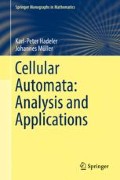Abstract
In the preceding section we introduced a classification of cellular automata based on attractors, their number and structure. In the present section we focus on the complexity of the dynamics. The two aspects are not independent, but differ slightly. We start with Devaney’s definition of chaos, and relate this definition to the Hurley classification. Thereafter we investigate a class of cellular automata that induce chaotic dynamics: permutive cellular automata. In the last part of this section we focus on one special property of chaotic dynamics: sensitive dependency on initial conditions. It is possible to recognize complex dynamics by inspecting the fate of two neighboring points.
Access this chapter
Tax calculation will be finalised at checkout
Purchases are for personal use only
References
J.-P. Allouchea, G. Skordev, Remarks on permutive cellular automata. J. Comput. Syst. Sci. 62, 174–182 (2003)
J. Banks, J. Brooks, G. Cairns, G. Davis, P. Stacy, On Devaney’s definition of chaos. Am. Math. Month. 99, 332–334 (1992)
G. Cattaneo, M. Finelli, L. Margara, Investigating topological chaos by elementary cellular automata dynamics. Theor. Comput. Sci. 244, 219–241 (2000)
T. Ceccherini-Silberstein, M. Coornaert, Cellular Automata and Groups. Springer Monographs in Mathematics (Springer, Berlin, 2010)
B. Codettoni, L. Margara, Transitive cellular automata are sensitive. Am. Math. Month. 103, 58–62 (1996)
R.L. Devaney, Chaotic Dynamical Systems (Westview Press, New York, 2003)
P. Favati, G. Lotti, L. Margara, Additive one-dimensional cellular automata are chaotic according to Devaney’s definition of chaos. Theor. Comput. Sci. 174, 157–170 (1997)
R. Gilman, Classes of linear automata. Ergod. Theory Dyn. Syst. 7, 105–118 (1987)
G. Hedlund, Endomorphisms and automorphisms of the shift dynamical systems. Math. Syst. Theory 3, 320–374 (1969)
P. Kůrka, Languages, equicontinuity and attractors in cellular automata. Ergod. Theory Dyn. Syst. 17, 417–433 (1997)
J.C. Oxtoby, S.M. Ulam, On the existence of a measure invariant under a transformation. Ann. Math. 40, 560–566 (1939)
Author information
Authors and Affiliations
Rights and permissions
Copyright information
© 2017 Springer International Publishing AG
About this chapter
Cite this chapter
Hadeler, KP., Müller, J. (2017). Chaos and Lyapunov Stability. In: Cellular Automata: Analysis and Applications. Springer Monographs in Mathematics. Springer, Cham. https://doi.org/10.1007/978-3-319-53043-7_6
Download citation
DOI: https://doi.org/10.1007/978-3-319-53043-7_6
Published:
Publisher Name: Springer, Cham
Print ISBN: 978-3-319-53042-0
Online ISBN: 978-3-319-53043-7
eBook Packages: Mathematics and StatisticsMathematics and Statistics (R0)

